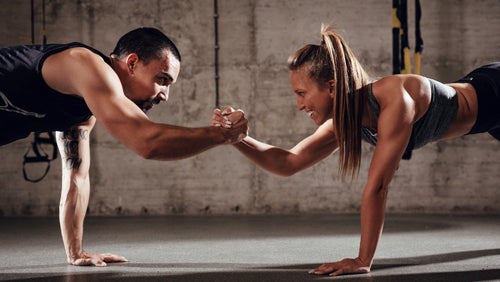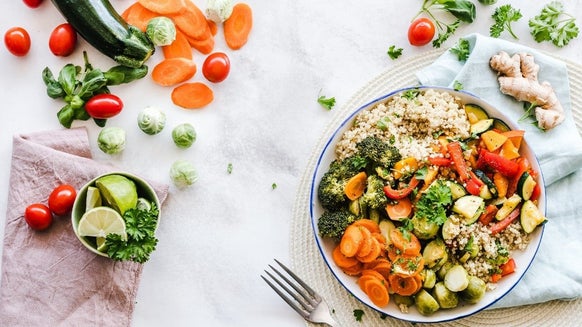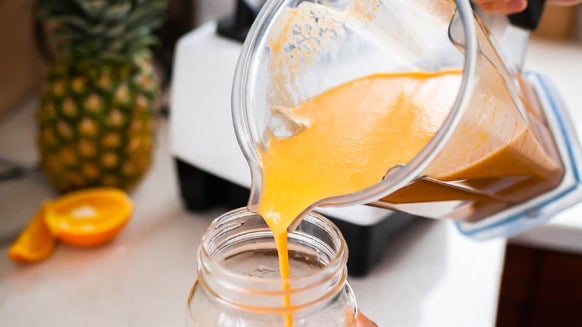How To Cut For Bodybuilding | Cutting Diet Plan & Top Tips

There are two main phases in a bodybuilding cycle — one phase is putting on as much quality muscle as possible, often called bulking or off-season. The second phase is trying to get as lean as possible, and is known as cutting or competition season. In this article we’ll go through how to set up your diet and training plan for a bodybuilding cut.
Bodybuilders are among the leanest athletes in sport by the time competition comes around. Male competitors often sit well below 10% body fat and female competitors can drop down close to 12%, and a little lower in some cases. Getting this lean requires serious commitment to the bodybuilding lifestyle, but there are ways to make the process easier if followed correctly.
- How to cut for bodybuilding
- Cutting diet plan
- Food choices while cutting
- Training while cutting
- Mealtimes
- When should I start cutting?
- 'Cheat' meals and refeed days
- Tips for your cutting diet

How to cut for bodybuilding
To lose weight and body fat, you need to be in a calorie deficit. This means you need to be burning off more energy than you consume.
Now, before you can create an energy deficit you need to work out how much you’re eating on average throughout the week. A simple way to do this is to track your daily food intake, along with your daily weight, and see what the average is for the week.
This could be as simple as downloading a food tracker app, recording what you eat each day and taking the average for the week. At the same time, you should weigh yourself each morning and look at your average over the week. This will give you an estimate of your weight, as it’s normal for it to fluctuate daily.
Next, you need to create a calorie deficit. To lose approximately 1lb of fat, you need a 3500kcal deficit throughout the week (that’s 500kcal less each day of the week). To lose 2lbs (approximately 1kg) a week, simply double the daily calorie deficit.2 It’s normal to lose fat more quickly during initial cutting stages when body fat is higher. As you start to get leaner, the rate should slow down as you don’t want to lose hard-earned muscle.
There are three main ways to lose body fat:
- Diet
- Training
- Cardio
Your diet will make the biggest difference to your fat loss. Training and general activity levels will contribute slightly to energy expenditure. Lastly, cardio can be added in a systematic way to help increase energy expenditure.3
So, the two sides of the energy balance equation are energy intake (how much you eat) and energy expenditure (how much activity and exercise you get in). A combination of less food and more exercise work in combination to get you bodybuilding lean.

Should I Use Creatine Whilst Cutting Fat?
Spoiler: Yes, and it can actually help your cut.
Cutting diet plan
Almost any diet can contribute towards your cutting phase if you have a large enough calorie deficit in place. While there are no particular types of foods more likely to make you gain weight (all foods contain calories), there are some foods that become more important during a cut and will make the process a lot easier. As mentioned above, calculating and sticking to a calorie deficit is the first step when starting your cut. Decide on the rate of weight loss you want — usually 0.5 to 1kg per week is a good place to start. This means you will need to be on a daily deficit of 500-1000kcal. 2
So, how does this look in real terms? If you weigh 90kg and consume on average 3000kcal per day and wanted to lose 1kg of fat per week, you need to create a daily deficit of 1000kcal per day.
This means you need to consume 2000kcals per day.
The next step is looking at your macronutrients. There are three macronutrients — protein, carbs and fats.
Protein:
Protein is arguably the key macronutrient. It’s responsible for maintaining lean muscle mass when cutting and aiding recovery from training. It also has the added benefit of keeping you full for longer. This is because it often takes a while to chew and digest solid proteins, so this helps curb hunger hormones.
How much protein should you consume while cutting?
Protein also has a high thermic effect of food, meaning it takes a lot of energy to break down, which is great during a cutting phase. A target of 2-2.4g per kilogram of bodyweight each day is good for most people on a bodybuilding cut. 3
Let’s stay with our example of 90kg bodyweight. We have a calorie-intake target of 2000kcals per day and a protein target of 180g (2g per kilo of bodyweight per day). 1g of protein has 4kcals, so this is 720kcals per day.
Fats:
These are a key component for your health and are an essential part of your diet. That means that you need dietary fats every day. Without them, many metabolic processes would shut down. Fats are responsible for producing powerful muscle hormones like testosterone, and for absorbing many vitamins and nutrients. 4
How much fat should you have while cutting?
Daily targets are usually set as a percentage of daily calories. The recommended amount of fat can be anywhere from 20% to 30% of your daily calories. Towards the end of cutting, fat intake might drop below this recommended amount for a small time because calories are low and protein needs to be kept high to maintain muscle. The shorter this period lasts, the better for your health.
Continuing with the example above, we can take 20% of 2000kcals, giveing us 400kcals a day from fat. To calculate how many grams of fat we need, we divide 400 by 9, as each gram of fat has 9 calories. So we have 44g of fat per day in our diet plan.
Carbohydrates:
These are the primary fuel source for bodybuilding training. Many people mistakenly believe you need to drop carbs to get lean. If carbs are dropped too low, training intensity lessens, which could lead to muscle loss. Most fruit and veg are carbs, so they play an important role for energy, health, recovery and immune function.7
How many Carbohydrates should you have while cutting?
Let’s go back to our 90kg, 2000kcals example:
We currently have 180g of protein (720kcals) and 44g of fats (400kcals) per day. To work out carbs needed, we take total daily calories (2000kcals) and subtract the calories from protein and fat we have already calculated.
2000 – 720 – 400 = 880kcals. To work out the amount of carbs, divide 880 by 4, as each gram of carbohydrate has 4kcals. This leaves us with 220g of carbs per day. Our calorie and macro split looks like this: 2000kcals per day; 180g protein; 44g fat and 220g carbs per day.
Food choices while cutting
A lot of people don’t know what type of foods they should eat when on a cut. This might be controversial to some, but ultimately a calorie is a calorie, and no specific food makes you put on weight. This, however, is only a small part of a bigger picture.
Hunger can be a real issue when going on a serious cut. While it might not be the food you eat that makes you gain weight, there are some foods that don’t do much to keep you full for long and leave you wanting more. These foods are often from more refined sources, and light up the pleasure responses in your brain.
If you’re fortunate enough not to get too hungry during your cut, you can be a lot more flexible in your food choices. If hunger is an issue (and it is for many people), then sticking to single-ingredient, whole-food sources might be a good idea.
Stick to lean complete proteins like chicken, fish and lean meats. For fats, choose healthy sources like oils and avocados, with a small amount of saturated fats from meat and dairy.
If most carbs you consume come from vegetables and other high-volume sources such as potato, oats, etc, then there’s a good chance hunger can be managed as much as possible.
If cravings come in, you can always include the odd treat in your diet, as long as it fits your macro target — just be sure to remember that you may trade off some tasty foods with being hungry.
Training while cutting
A lot of people make the mistake of changing their training too much when going on a cut. Usually, most muscle is gained in the 8--12 rep range. 6
What you don’t want to do when starting a cut is to suddenly drop weights and only use a high-rep routine. This is one way to lose hard-earned muscle gained during a bulk. What you want to do is train with the heaviest weight you can within the 8-12 rep range, and stick to what worked to put on muscle in the first place. 6
Your weightlifting workouts should be used to help keep your muscle mass as high as possible, and not to lose body fat. Your diet and cardio should be enough to help you lose weight and get into the shape you want. 3

The Science Behind Getting Motivated To Work Out
Do these studies have the answers for you?
Mealtimes
Mealtimes don’t play a big part in a bodybuilding cut but they can be useful to help keep hunger at bay. Since the usual protein goal is high (at least 2g per kg), it might be easier to spread protein over a few meals in the day, to get the greatest anabolic effect (promoting muscle growth). 3
While you might choose to consume carbs around your workout to help perform better, this might not always be the best option. By doing this you might be hungry at times when the energy could be of better use. The main aim of the diet is to get lean, and the best way to do this is to combat hunger and eat when you’re most hungry. Meal frequency and timings don’t matter a huge deal, so choose a frequency and timing split that keeps you full and the hunger at bay.
Protein might be the exception — you should have a minimum of two and a possible maximum of six protein meals per day.
When should I start cutting?
If you’re thinking of getting on stage, it’s better to give yourself more time to lose body fat than less time. Most people don’t realise how much body fat they carry and getting on stage takes cutting to a whole new level.
If you are in good shape and already fairly lean, then your bodybuilding cut could start 16 weeks out. This will give you time to ease into the last few weeks without rushing things and potentially losing muscle. If you aren’t in as good shape, the process could take up to six months, with multiple cutting and diet-break cycles.
Seek a coach or an experienced bodybuilder to give you an honest opinion of where you currently stand and plan to give yourself more time to diet than you might need. The results will be worth it.
Cheat meals and refeed days
If you’re wondering about cheat meals and refeed days in your cutting diet plan, there are a few schools of thought. Although research shows that a higher carb intake after low-carb dieting can increase muscle thickness1, it can be hard for some people to get back on track after a cheat day. A cutting diet plan is very specific, but some swear by “refeed days” to not feel deprived and to keep your body from getting too stressed and your metabolism slowing down.2 If you find yourself feeling completely drained and super hungry all the time, it’s worth considering a refeed day or cheat meal in your cutting diet plan.
Tips for your cutting diet
Use these tips to help your cutting diet be successful.
- Eat more fibre: fruits, vegetables, beans and whole grains high in fibre will keep you feeling fuller for longer by adding bulk to your meals.
- Drink lots of water: keeping your muscles hydrated is always important, but especially when cutting and consuming high amounts of protein and fibre.
- Avoid drinking your calories: limit any sugary beverages or “empty” calories from drinks that aren’t helping you to hit your protein goals. Increase your low-intensity cardio to preserve muscle but assist with calorie deficit
Take home message
A bodybuilding cut can be one of the most rewarding and challenging experiences you ever have. It’s a lifestyle that requires extreme dedication, but the payoff is worth it. The most important thing is to set up a calorie deficit and to get enough protein in your diet. The number of carbs and fats needed varies from person to person, depending on dietary preferences. Hunger can also be an issue, so remember to choose both foods and timings that keep you full and satisfied.
READ THESE NEXT:

Grant is a sports nutritionist and certified strength coach. He has multiple postgraduate diplomas in nutrition and strength coaching as well as a Master’s degree in Sports and Exercise Nutrition, with a specific focus on protein. Grant has worked in the fitness industry for well over a decade and has helped coach professional athletes and sports teams, as well as the average gym-goer looking to get in the best shape possible. He now spends most of his working time teaching fitness professionals and coaching people remotely.
He’s a big believer in practising what he preaches and has been involved in resistance training and martial arts for over 20 years. In his spare time, Grant enjoys being with his wife and daughter as well as the family dogs and catching up on the latest Netflix series.
Find out more about Grant’s experience here and about his personal training here.
1. Chappell, A. J., Simper, T., & Barker, M. E. (2018). Nutritional strategies of high level natural bodybuilders during competition preparation. Journal of the International Society of Sports Nutrition, 15. https://doi.org/10.1186/s12970-018-0209-z
2. Hall, K. D. (2008). What is the Required Energy Deficit per unit Weight Loss? International Journal of Obesity (2005), 32(3), 573–576. https://doi.org/10.1038/sj.ijo.0803720
3. Helms, E. R., Aragon, A. A., & Fitschen, P. J. (2014). Evidence-based recommendations for natural bodybuilding contest preparation: nutrition and supplementation. Journal of the International Society of Sports Nutrition, 11, 20. https://doi.org/10.1186/1550-2783-11-20
4. Liu, A. G., Ford, N. A., Hu, F. B., Zelman, K. M., Mozaffarian, D., & Kris-Etherton, P. M. (2017). A healthy approach to dietary fats: understanding the science and taking action to reduce consumer confusion. Nutrition Journal, 16. https://doi.org/10.1186/s12937-017-0271-4
5. Mitchell, L., Slater, G., Hackett, D., Johnson, N., & O’connor, H. (2018). Physiological implications of preparing for a natural male bodybuilding competition. European Journal of Sport Science, 18(5), 619–629. https://doi.org/10.1080/17461391.2018.1444095
6. SCHOENFELD, B. J., CONTRERAS, B., KRIEGER, J., GRGIC, J., DELCASTILLO, K., BELLIARD, R., & ALTO, A. (2019). Resistance Training Volume Enhances Muscle Hypertrophy but Not Strength in Trained Men. Medicine and Science in Sports and Exercise, 51(1), 94–103. https://doi.org/10.1249/MSS.0000000000001764
7. Slavin, J. L., & Lloyd, B. (2012). Health Benefits of Fruits and Vegetables1. Advances in Nutrition, 3(4), 506–516. https://doi.org/10.3945/an.112.002154
8. Schoenfeld, B. J., Alto, A., Grgic, J., Tinsley, G., Haun, C. T., Campbell, B. I., … & Trexler, E. T. (2020). Alterations in body composition, resting metabolic rate, muscular strength, and eating behavior in response to natural bodybuilding competition preparation: A case study. The Journal of Strength & Conditioning Research, 34(11), 3124-3138.
9. Chaput, J. P., Drapeau, V., Hetherington, M., Lemieux, S., Provencher, V., & Tremblay, A. (2007). Psychobiological effects observed in obese men experiencing body weight loss plateau. Depression and anxiety, 24(7), 518-521.










